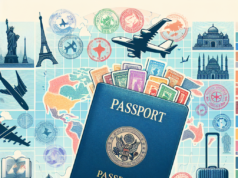
Introduction
The United States is a nation of immigrants and has a long-standing history of welcoming individuals from all over the world. However, in recent years, immigration has become a contentious issue, with some arguing that the U.S. has an insufficient immigration process in place. Many people wonder, does the U.S. have an immigration process? The answer is yes. In this article, we will explore the U.S. immigration process in detail, including the requirements, the different types of visas, and the steps involved in obtaining them.
Requirements for Immigration
The requirements for immigration to the U.S. vary depending on the person’s circumstances. Generally, to immigrate to the U.S., an individual must meet the following criteria:
1. Health
The applicant must be in good health and have no infectious diseases that could be a public health risk.
2. Education and Experience
The education and experience requirements for immigration vary depending on the type of visa or green card being applied for. Typically, visas that require higher education or specialized skills will require more formal education and work experience.
3. Security and Background Checks
All prospective immigrants undergo security and background checks to verify they do not have a criminal background or pose any national security threats.
4. Financial Capability
To be eligible for immigration, visa applicants must possess sufficient financial capability to support themselves or have a sponsor.
Types of Visas
There are numerous types of visas available for those seeking to immigrate to the U.S. These include:
1. Family-Based Visa
A family-based visa is for intending immigrants who have a close family member who is a U.S. citizen or permanent resident.
2. Employment-Based Visas
Employment-based visas are available to professionals and skilled workers who have an offer of employment in the U.S. or are considered to be of high-value to the U.S. economy.
3. Diversity Visa (Green Card Lottery)
The Diversity Visa Program is a lottery-based system that randomly selects individuals from countries that have low immigration rates to the U.S. Each year, about 55,000 green cards are made available to the winners of the Diversity Visa Program.
4. Investor Visa
An investor visa (EB-5) can be obtained by investing at least $900,000 in a new or existing U.S. business that creates a minimum of 10 jobs.
5. Special Immigrant Visa
Special immigrant visas are for those who have served in the U.S. military, or who have worked for the U.S. government in certain capacities.
6. Student Visa
Student visas are for foreign nationals who wish to study in the United States and attend either a high school, university, or vocational school.
7. Tourist Visa
A tourist visa is granted to visitors who wish to travel to the U.S. for tourism or business purposes.
Steps in the Immigration Process
The immigration process can be complex and time-consuming. There are several steps involved in the process, which include:
1. Filing Petition
The first step in the immigration process is to file a petition with U.S. Citizenship and Immigration Services (USCIS). Depending on the type of visa, the petitioner may need to show that the applicant qualifies for the visa type they are applying for.
2. Approval of Petition
Once the petition is filed, USCIS reviews the application and supporting documentation to determine eligibility. If the petition is approved, USCIS will forward the case to the National Visa Center (NVC).
3. Submission of Required Documents
The next step in the process is to submit the required documents to the NVC. The documents required may vary depending on the type of visa, but generally will include:
– A copy of a valid passport for the applicant and any accompanying family members
– An Affidavit of Support, which verifies that the applicant has financial support in the U.S.
– Birth, marriage, and police certificates, as well as any additional supporting documentation required for the specific visa type.
4. Consular Interview
After the NVC has received all of the required documents, they will schedule a consular interview at the U.S. embassy or consulate in the applicant’s country of residence. The applicant and any accompanying family members must attend the interview.
5. Medical Exam and Vaccinations
Before the interview, the applicant will need to complete a medical exam with an authorized physician. The medical exam will include a physical exam, blood tests, and vaccinations required for entry into the U.S.
6. Final Decision
Once the consular interview has been completed, the consular officer will make a final decision on the visa application. If approved, the applicant and any accompanying family members will receive their visa and can begin the process of entering the U.S.
Current U.S. Immigration Policy
In recent years, U.S. immigration policy has been the subject of heated political debate. The Trump administration, in particular, took a hardline stance on immigration, seeking to reduce both legal and illegal immigration to the U.S.
The Biden administration has taken a different approach, focusing on changing immigration policies to prioritize family reunification, increase the number of green cards available, and provide a pathway to citizenship for undocumented immigrants.
The Biden administration has also overturned several key Trump-era immigration policies, including the travel ban on predominantly Muslim countries and the Remain in Mexico policy that required asylum seekers to stay in Mexico while their cases were being processed.
Conclusion
While the U.S. immigration process can be complex and time-consuming, the United States does have an immigration process in place. The requirements, types of visas, and steps involved in obtaining them vary depending on the individual’s circumstances. While U.S. immigration policy has shifted in recent years, it remains important for prospective immigrants to stay up-to-date on any policy changes that may impact their ability to immigrate to the U.S.
The legal immigration process for entry into the U.S. comes under the authority of various agencies, including the U.S. Citizenship and Immigration Services (USCIS) and the National Visa Center.
In general, legal immigration can be enabled by the individual applicant being sponsored by a person who is already a citizen or permanent resident (Green Card holder) of the U.S, and who is connected to that individual in some demonstrable way, as a family member or a potential employer.
The legal immigration process accordingly begins with an immigration petition, Form I-130, being submitted by the prospective immigrant’s sponsor, either to the USCIS or to the nearest applicable consulate or embassy. The petition will then be forwarded to the National Visa Center, which will schedule interviews for applicants which it accepts.
If the applicant undergoes the interview successfully, he or she will then empowered, through a visa, to travel to a U.S. port of entry and considered for legal immigration.
In accordance to its definition, the immigration process is simply the moving of people into a different location. However, to immigrate in modern terms refers to the moving of people from one country to another, usually for the purpose of establishing a better quality of life. However, the immigration process is not as simple as traveling and entering another nation. Immigration laws imposed by countries will make the immigration process a more standardized and legal procedure.
To immigrate to another country, regardless of the purpose, will require that certain laws be followed and that certain procedures take place in order to lawfully enter another country. Immigration laws vary from country to country, though most will require specific documentation in order to allow those that immigrate to a country to enter under lawful terms. Typically, this will entail securing a visa and passport.


























